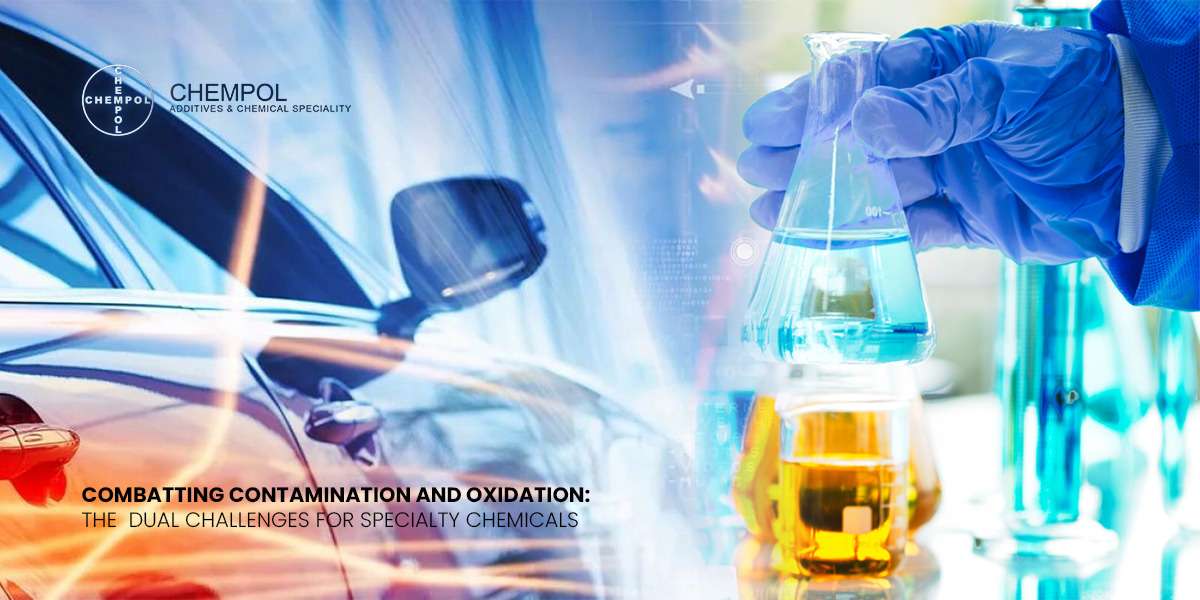
Combatting Contamination and Oxidation: The Dual Challenges For Specialty Chemicals
In the progressing world of the lubricant industry, sustainability has emerged as a critical element, guiding not just environmental responsibility but also influencing the core strategies for the longevity and performance of lubricants. The intricate relationship between specialty chemicals and lubricants is fundamental to understanding how lubricants deteriorate and the innovative solutions that can combat this degradation, ensuring efficiency and extending the life of these essential fluids.
Contamination and Oxidation Challenges in Lubricant Maintenance
Lubricating oils are prone to deterioration through two principal avenues: contamination and the inexorable chemical changes wrought by oxidation. In the harsh environments of engines, lubricants are besieged by contaminants such as airborne dust, metallic wear particles, unburnt fuel, fuel combustion by-products, and intrusive water. These foreign entities compromise the lubricant’s purity and, by extension, its performance.
The chemical battlefield within the lubricant is equally daunting. Oxidation triggers a cascade of reactions, yielding weak organic acids and altering the lubricant’s chemical makeup. This transformation not only diminishes the lubricant’s efficacy but also paves the way for the formation of strong acids when contaminants from fuel combustion—specifically oxides of sulfur and nitrogen—introduce themselves into the mix. While recent trends have seen a reduction in sulfur content in diesel fuels, which has somewhat alleviated this issue, the threat remains pertinent.
Role of Specialty Chemicals in Enhancing Lubricant Performance and Longevity

Herein lies the valor of specialty chemicals, which are thoroughly engineered to shield lubricants from these relentless assaults. These chemical guardians are designed to neutralize contaminants, stabilize the lubricant composition, and halt oxidative chain reactions. By doing so, they preserve the lubricant’s integrity, maintain its performance, and extend its service life.
Specialty chemicals for lubricants are not a mere luxury but a necessity, especially in the modern era where the demand for lubricants parallels the demand for performance and sustainability. The role of these chemicals is multifaceted—they serve as antioxidants, detergents, dispersants, and anti-wear agents, forming an impenetrable defense against the myriad of contaminants and the deleterious effects of oxidation.
Chempol, a vanguard in the specialty chemical manufacturing space, has created an array of these chemical saviors. By harnessing cutting-edge science and technology, Chempol synthesizes chemicals that are not only reactive protectors but also proactive enhancers of lubricant life and performance. Their products are a blend of innovation and environmental stewardship, tailored to the unique needs of the lubricant industry.
Chempol’s Innovative Chemical Solutions for Lubricants
Chempol’s chemical solutions address the core issues faced by lubricants. For instance, their antioxidants are designed to intercept and neutralize free radicals, the harbingers of oxidation, thus preserving the lubricant’s structure and function. Similarly, Chempol’s detergents and dispersants keep contaminants in suspension, preventing them from coalescing and causing damage. This action ensures that contaminants are removed effectively during oil changes or filtration processes.
Chempol develops such chemicals to consider the shifting compositions of fuels and the implications for lubricant contamination. By adapting the formulation of their specialty chemicals, Chempol confirms that their products can cope with the changing landscape of fuel sulfur content, planning a tough shield against any resultant acidic attacks on the lubricant.
Enhancing Lubricant Efficiency and Sustainability: The Essential Role of Specialty Chemicals in Modern Industry

As global demand for lubricants grows, spurred by industrial expansion and the proliferation of machinery, the role of specialty chemicals becomes ever more critical. These chemicals are helpful in confirming that lubricants can meet the exact demands of various functions, from the high-temperature crucible of combustion engines to the precision-required operation of industrial machinery. They are no longer a possible chemical but a central component of a comprehensive lubricant application and its performance.
In essence, Chempol and its specialty chemicals are not just manufacturing products; they are cultivating reliability, performance, and longevity in lubricants. They are enabling a future where machinery runs smoother for longer, where maintenance costs are reduce, and where the environmental footprint of lubricants is minimiz. The partnership between specialty chemicals and lubricants is an emblem of the modern industry’s commitment to sustainability, efficiency, and innovation.
CHEMPOL Yellow Dyes

Typical Characteristics:
- Odor: It smells typical of the chemicals in its group, which is aromatic, meaning it likely has a distinct, sometimes pleasant smell.
- Appearance: Visually, it looks like a dark yellow liquid.
- Specific Gravity: This measures the density of the liquid. With water being 1.00, this liquid is slightly less dense at 0.991. This means it’s almost as heavy as water but just a bit lighter.
- Flash Point (PMCC): This is the temperature at which the liquid can catch fire, which is 63°C. It’s a way to recognize how flammable the liquid is.
- Unsolvable Substance: This tells us that 0.81% of the element will not dissolve in toluene, a common solvent in lubricants.
- Moisture Substance: Only 0.11% of this substance is water, which is friendly for the lubricant.
Physical Properties:
- Solubility: This part tells us that the element can dissolve in lubricants. It does not dissolve in water, but it can liquefy benzene, xylene, and oils.
Chemical Properties:
- Solvent Chemistry: It indicates that the chemical can act like a solvent and is similar to substances like xylene, dimethylbenzene, or alkylbenzene, which are types of chemicals that can dissolve other substances in it.
This is a specialty chemical that has a smell, looks yellow, and is almost as dense as water. It can catch fire if it gets hot enough. Furthermore, it doesn’t mix well with water but can dissolve in some other specific chemicals.
But if you want to know more about Chempol’s specialty chemicals, you can see through the website. There are a variety of chemicals like Chempol blue dyes, brown dyes, green dyes, and red dyes. They have their specifications and properties on the website.
The incorporation of specialty chemicals into lubricants reflects the industry’s foresight and commitment to excellence. Companies like Chempol are at the forefront of this revolution, engineering chemicals that safeguard lubricants from the inevitable decline while bolstering their performance. As we advance, these chemicals will continue to play a vital role in the lubricant industry, making certain that the gears of progress turn with uninterrupted, sustainable momentum.


